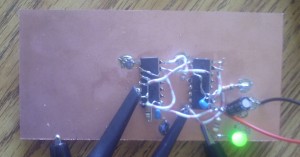47 CFR 97.311 gives amateur radio operator in the US the privilege of experimenting with Direct Sequence and Frequency Hopping Spread Spectrum. Frequency Hopping Spread Spectrum (FHSS) is not interesting to me as good designs already exist and FHSS is no longer considered secure. Direct Sequence Spread Spectrum (DSSS) on the other hand takes a load of background knowledge to design and develop circuitry. In other words, DSSS is exactly the kind of challenge I need.
In a nutshell a DSSS signal is created by spreading a narrowband signal over a much larger bandwidth using a pseudorandom bit sequence (PRBS). The original signal can be recovered at the receiver by despreading the signal using the same PRBS.
What sounds pretty simple is actually quite a tough task from an engineering standpoint. The code sequence in both the transmitter and receiver need to be exactly synchronous. It goes without saying that the toughest tasks are carrier recovery and code synchronization.
Over the course of the next months I will post some of my Direct Sequence Spread Spectrum experiments. I believe this will be a fun project and prove that amateur radio is anything but amateur.
Links and Sources:
[1] Book: Kesteloot, Andre (1991). Spread Spectrum Sourcebook. American Radio Relay League.
Westerhold, S. (2012), "Direct Sequence Spread Spectrum Experiments". Baltic Lab High Frequency Projects Blog. ISSN (Online): 2751-8140., https://baltic-lab.com/2012/08/direct-sequence-spread-spectrum-experiments/, (accessed: December 31, 2025).
- Conducted Emissions on the Bench: Implementing the CISPR 25 Voltage Method - December 15, 2025
- WebP-Images without Plugin - January 14, 2025
- Firewall Rules with (dynamic) DNS Hostname - January 14, 2025

Closer look at a Direct Sequence Spread Spectrum Signal | KF5OBS /IP
[…] while back, I posted a Pseudorandom Number Generator (PRNG) for Direct Sequence Spread Spectrum (DSS) experiments. PRNGs are the key element in many crystallographic applications and they also play a major role in […]
Christopher Williams (N3YCJ)
As an amateur radio operator, I was always under the impression ,from my testing days, that you were not supposed to use any kinds of code or methods of ‘encryption’. What I don’t quite follow is your interpretation of 47 CFR 97.311. Sub-section ‘a.’ states that you may not use spread spectrum for “… the purpose of obscuring the meaning of any communication.”. It seems that your reasons for these experiments are exactly that…
Now as far as a technical problem goes, your work looks quite good and I commend you.
KF5OBS
Christopher, the use of codes (PN-sequence) is a main and essential component of Spread Spectrum communication. You can not have Spread Spectrum without some sort of code sequence. The FCC doesn’t disallow encryption per se, they solely disallow it for the purpose of obscuring messages. If I wanted to pass you a message and don’t want anybody else to intercept it, the use of Spread Spectrum and other encryption methods is unlawful. If however, I use encryption to ensure data integrity, the use of the same encryption mechanism is now legal. That confuses many amateur radio operators. So even though Spread Spectrum is a very powerful cryptographic instrument, it may be used if the disguise of a message is not the primary intent.